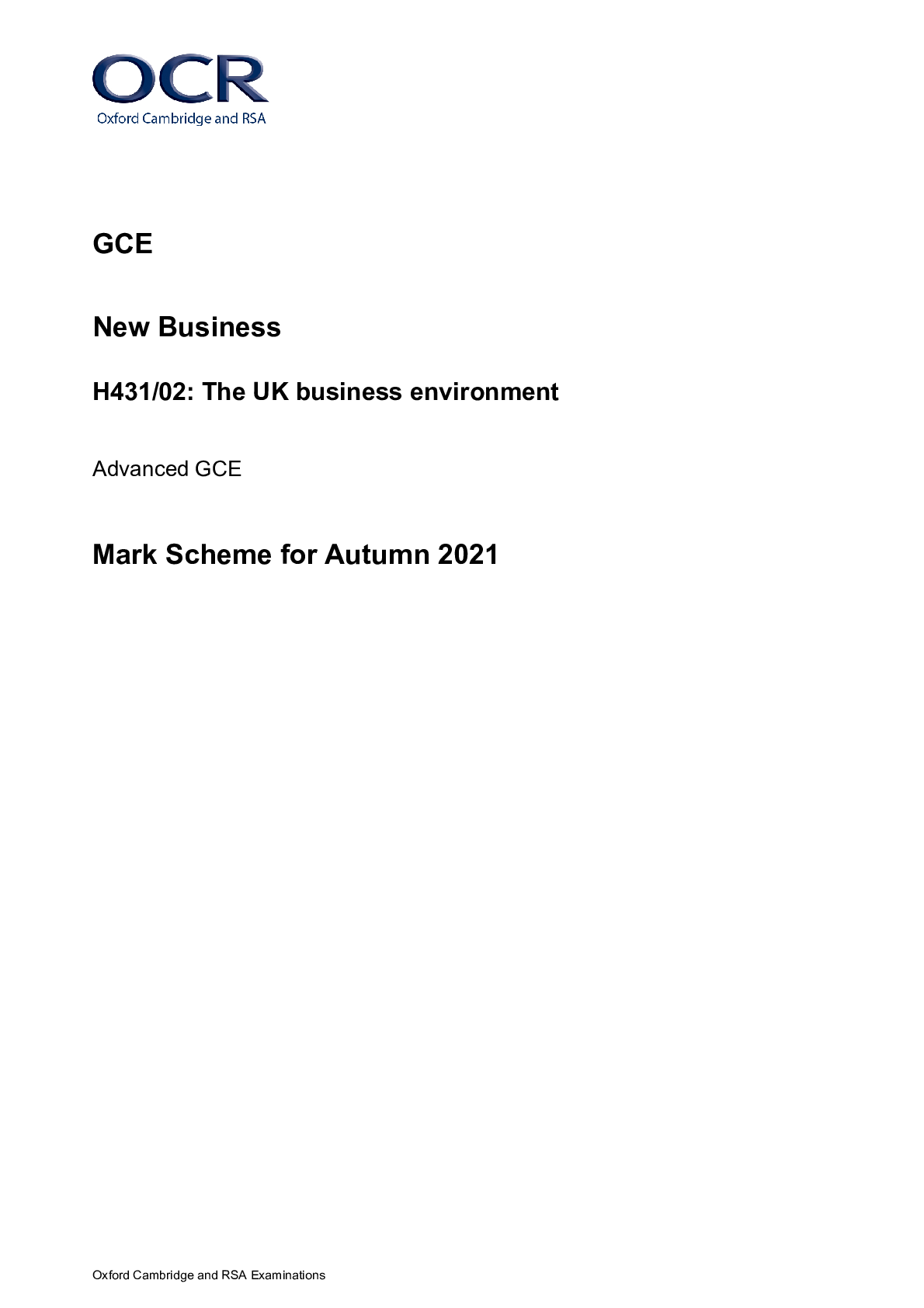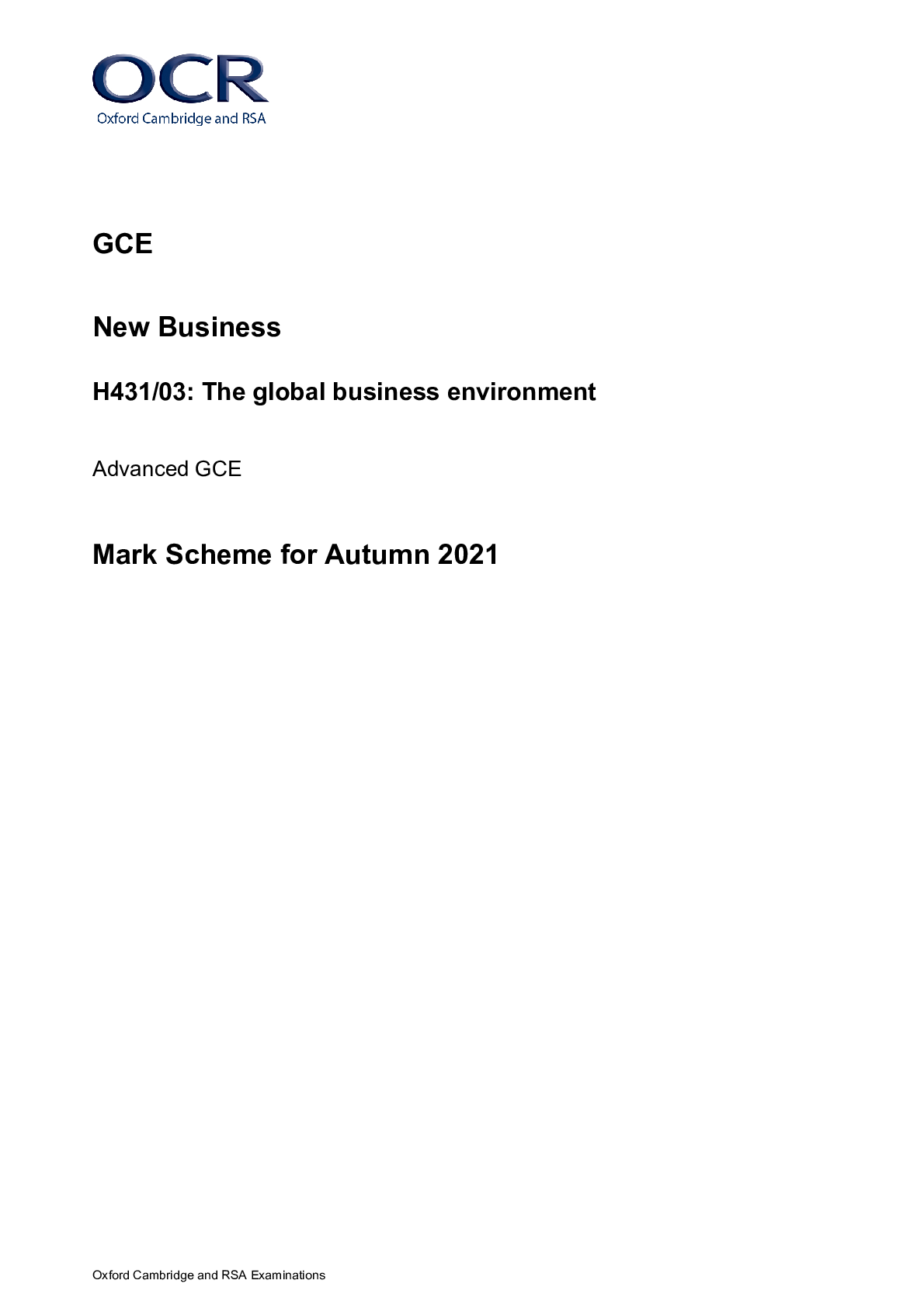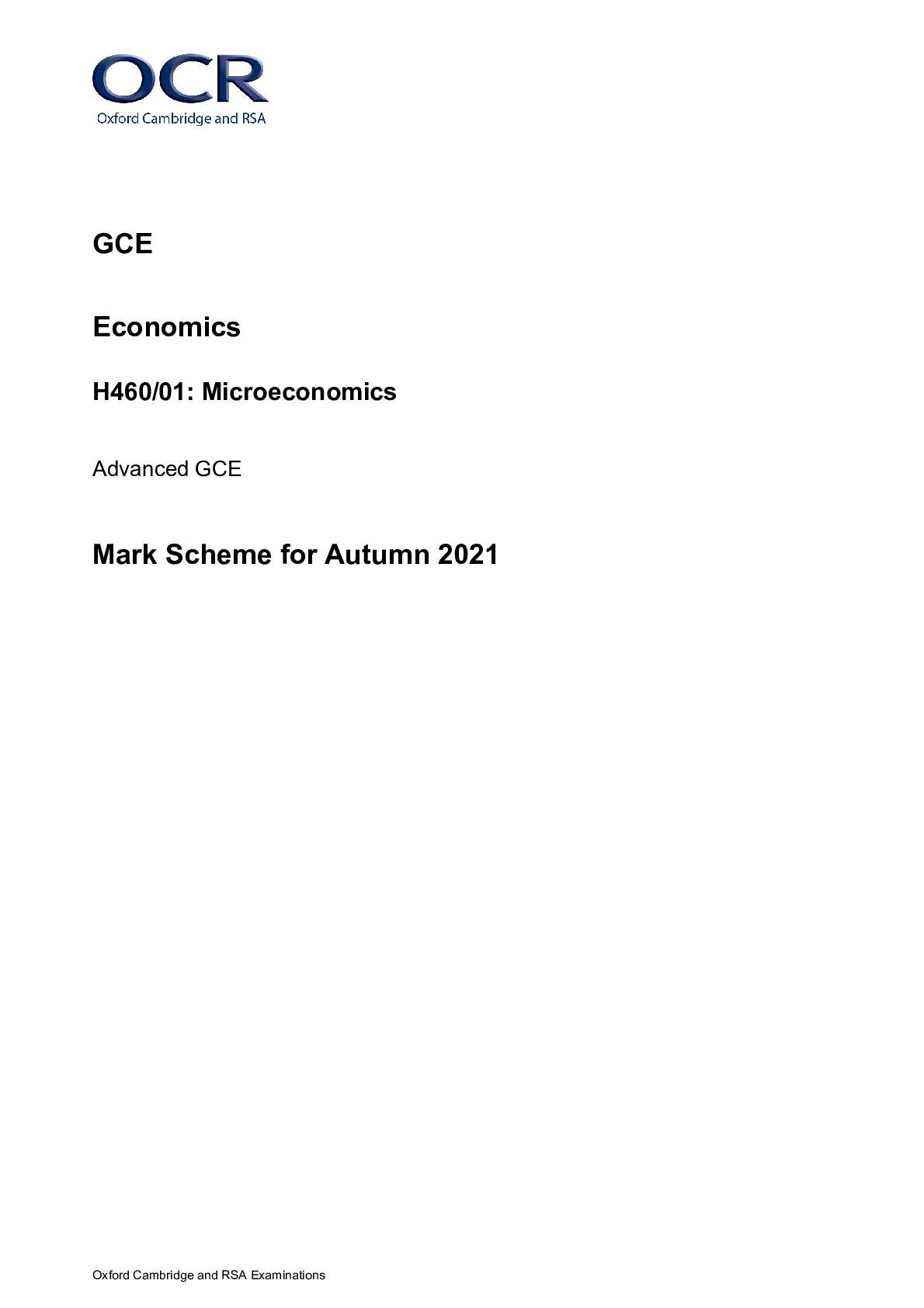Mathematics > MARK SCHEME > GCE Mathematics B (MEI) H640/02: Pure Mathematics and Statistics Advanced GCE Mark Scheme for Autumn (All)
GCE Mathematics B (MEI) H640/02: Pure Mathematics and Statistics Advanced GCE Mark Scheme for Autumn 2021
Document Content and Description Below
GCE Mathematics B (MEI) H640/02: Pure Mathematics and Statistics Advanced GCE Mark Scheme for Autumn 2021 Oxford Cambridge and RSA Examinations GCE Mathematics B (MEI) H640/02: Pure Mathemat... ics and Statistics Advanced GCE Mark Scheme for Autumn 2021Oxford Cambridge and RSA Examinations OCR (Oxford Cambridge and RSA) is a leading UK awarding body, providing a wide range of qualifications to meet the needs of candidates of all ages and abilities. OCR qualifications include AS/A Levels, Diplomas, GCSEs, Cambridge Nationals, Cambridge Technicals, Functional Skills, Key Skills, Entry Level qualifications, NVQs and vocational qualifications in areas such as IT, business, languages, teaching/training, administration and secretarial skills. It is also responsible for developing new specifications to meet national requirements and the needs of students and teachers. OCR is a not-for-profit organisation; any surplus made is invested back into the establishment to help towards the development of qualifications and support, which keep pace with the changing needs of today’s society. This mark scheme is published as an aid to teachers and students, to indicate the requirements of the examination. It shows the basis on which marks were awarded by examiners. It does not indicate the details of the discussions which took place at an examiners’ meeting before marking commenced. All examiners are instructed that alternative correct answers and unexpected approaches in candidates’ scripts must be given marks that fairly reflect the relevant knowledge and skills demonstrated. Mark schemes should be read in conjunction with the published question papers and the report on the examination. © OCR 2021H640/02 Mark Scheme November 2021 1. Annotations and abbreviations Annotation in scoris Meaning and BOD Benefit of doubt FT Follow through ISW Ignore subsequent working M0, M1 Method mark awarded 0, 1 A0, A1 Accuracy mark awarded 0, 1 B0, B1 Independent mark awarded 0, 1 E Explanation mark 1 SC Special case ^ Omission sign MR Misread BP Blank page Highlighting Other abbreviations in mark scheme Meaning E1 Mark for explaining a result or establishing a given result dep* Mark dependent on a previous mark, indicated by *. The * may be omitted if only previous M mark. cao Correct answer only oe Or equivalent rot Rounded or truncated soi Seen or implied www Without wrong working AG Answer given awrt Anything which rounds to BC By Calculator DR This indicates that the instruction In this question you must show detailed reasoning appears in the question.H640/02 Mark Scheme November 2021 2. Subject-specific Marking Instructions for AS/A Level Mathematics B (MEI) a a Annotations must be used during your marking. For a response awarded zero (or full) marks a single appropriate annotation (cross, tick, M0 or ^) is sufficient, but not required. For responses that are not awarded either 0 or full marks, you must make it clear how you have arrived at the mark you have awarded and all responses must have enough annotation for a reviewer to decide if the mark awarded is correct without having to mark it independently. It is vital that you annotate standardisation scripts fully to show how the marks have been awarded. Award NR (No Response) - if there is nothing written at all in the answer space and no attempt elsewhere in the script - OR if there is a comment which does not in any way relate to the question (e.g. ‘can’t do’, ‘don’t know’) - OR if there is a mark (e.g. a dash, a question mark, a picture) which isn’t an attempt at the question. Note: Award 0 marks only for an attempt that earns no credit (including copying out the question). If a candidate uses the answer space for one question to answer another, for example using the space for 8(b) to answer 8(a), then give benefit of doubt unless it is ambiguous for which part it is intended. b An element of professional judgement is required in the marking of any written paper. Remember that the mark scheme is designed to assist in marking incorrect solutions. Correct solutions leading to correct answers are awarded full marks but work must not always be judged on the answer alone, and answers that are given in the question, especially, must be validly obtained; key steps in the working must always be looked at and anything unfamiliar must be investigated thoroughly. Correct but unfamiliar or unexpected methods are often signalled by a correct result following an apparently incorrect method. Such work must be carefully assessed. When a candidate adopts a method which does not correspond to the mark scheme, escalate the question to your Team Leader who will decide on a course of action with the Principal Examiner. If you are in any doubt whatsoever you should contact your Team Leader.H640/02 Mark Scheme November 2021 c The following types of marks are available. MA suitable method has been selected and applied in a manner which shows that the method is essentially understood. Method marks are not usually lost for numerical errors, algebraic slips or errors in units. However, it is not usually sufficient for a candidate just to indicate an intention of using some method or just to quote a formula; the formula or idea must be applied to the specific problem in hand, e.g. by substituting the relevant quantities into the formula. In some cases the nature of the errors allowed for the award of an M mark may be specified. A method mark may usually be implied by a correct answer unless the question includes the DR statement, the command words “Determine” or “Show that”, or some other indication that the method must be given explicitly. AA ccuracy mark, awarded for a correct answer or intermediate step correctly obtained. Accuracy marks cannot be given unless the associated Method mark is earned (or implied). Therefore M0 A1 cannot ever be awarded. B Mark for a correct result or statement independent of Method marks. EA given result is to be established or a result has to be explained. This usually requires more working or explanation than the establishment of an unknown result. Unless otherwise indicated, marks once gained cannot subsequently be lost, e.g. wrong working following a correct form of answer is ignored. Sometimes this is reinforced in the mark scheme by the abbreviation isw. However, this would not apply to a case where a candidate passes through the correct answer as part of a wrong argument. d When a part of a question has two or more ‘method’ steps, the M marks are in principle independent unless the scheme specifically says otherwise; and similarly where there are several B marks allocated. (The notation ‘dep*’ is used to indicate that a particular mark is dependent on an earlier, asterisked, mark in the scheme.) Of course, in practice it may happen that when a candidate has once gone wrong in a part of a question, the work from there on is worthless so that no more marks can sensibly be given. On the other hand, when two or more steps are successfully run together by the candidate, the earlier marks are implied and full credit must be given. e The abbreviation FT implies that the A or B mark indicated is allowed for work correctly following on from previously incorrect results. Otherwise, A and B marks are given for correct work only – differences in notation are of course permitted. A (accuracy) marks are not given for answers obtained from incorrect working. When A or B marks are awarded for work at an intermediate stage of a solution, there may be various alternatives that are equally acceptable. In such cases, what is acceptable will be detailed in the mark scheme. If this is not the case, please escalate the question to your Team Leader who will decide on a course of action with the Principal Examiner. Sometimes the answer to one part of a question is used in a later part of the same question. In this case, A marks will often be ‘follow through’. In such cases you must ensure that you refer back to the answer of the previous part question even if this is not shown within the image zone. You may find it easier to mark follow through questions candidate-by-candidate rather than question-by-question.H640/02 Mark Scheme November 2021 f Unless units are specifically requested, there is no penalty for wrong or missing units as long as the answer is numerically correct and expressed either in SI or in the units of the question. (e.g. lengths will be assumed to be in metres unless in a particular question all the lengths are in km, when this would be assumed to be the unspecified unit.) We are usually quite flexible about the accuracy to which the final answer is expressed; over-specification is usually only penalised where the scheme explicitly says so. • When a value is given in the paper only accept an answer correct to at least as many significant figures as the given value. • When a value is not given in the paper accept any answer that agrees with the correct value to 2 s.f. unless a different level of accuracy has been asked for in the question, or the mark scheme specifies an acceptable range. NB for Specification A the rubric specifies 3 s.f. as standard, so this statement reads “3 s.f” Follow through should be used so that only one mark in any question is lost for each distinct accuracy error. Candidates using a value of 9.80, 9.81 or 10 for g should usually be penalised for any final accuracy marks which do not agree to the value found with 9.8 which is given in the rubric. g Rules for replaced work and multiple attempts: • If one attempt is clearly indicated as the one to mark, or only one is left uncrossed out, then mark that attempt and ignore the others. • If more than one attempt is left not crossed out, then mark the last attempt unless it only repeats part of the first attempt or is substantially less complete. • if a candidate crosses out all of their attempts, the assessor should attempt to mark the crossed out answer(s) as above and award marks appropriately. h For a genuine misreading (of numbers or symbols) which is such that the object and the difficulty of the question remain unaltered, mark according to the scheme but following through from the candidate’s data. A penalty is then applied; 1 mark is generally appropriate, though this may differ for some units. This is achieved by withholding one A or B mark in the question. Marks designated as cao may be awarded as long as there are no other errors. If a candidate corrects the misread in a later part, do not continue to follow through. E marks are lost unless, by chance, the given results are established by equivalent working. Note that a miscopy of the candidate’s own working is not a misread but an accuracy error. i If a calculator is used, some answers may be obtained with little or no working visible. Allow full marks for correct answers provided that there is nothing in the wording of the question specifying that analytical methods are required such as the bold “In this question you must show detailed reasoning”, or the command words “Show” and “Determine. Where an answer is wrong but there is some evidence of method, allow appropriate method marks. Wrong answers with no supporting method score zero. If in doubt, consult your Team Leader. j If in any case the scheme operates with considerable unfairness consult your Team Leader.H640/02 Mark Scheme November 2021 Question Answer Marks AOs Guidance 1 (� =) 4(��)2 + 8(��) + 1 soi M1 1.1a � = 1 2 ; condone � = 2; condone omission of brackets y = x² + 4x + 1 isw A1 1.1 must see “y =” either here or in first line [2] 2 (a) 65 × � 180 soi M1 1.1a may be implied by 1.13(4464…) or 0.36…× π 13� 36 A1 1.1 [2] 2 (b) 12.1 B1 1.1 ignore units [1] 3 M1 A1 A1 1.2 1.1 2.5 line from 2 to 7 only (do not need number line) one end correctly shaded both ends correctly shaded if M0 allow SC1 for one end correct [3] 4 M1 M1 A1 1.1 1.1 1.1 � = 2� − 3 correct in first quadrant; may be implied by reflection or by A1 reflection of their straight line to form V shape for positive y only symmetrical V shape through (0,3) with vertex at (1.5, 0) ; points may be identified from numbered scale or written separately condone branches of different lengths [3] 5 (a) 0.14, 0.139 or awrt 0.1385 isw BC B1 1.1 [1]H640/02 Mark Scheme November 2021 Question Answer Marks AOs Guidance 5 (b) P(X ≤ 7) = 0.0248(2…) soi or 0.9751 to 0.9752 seen M1 1.1 if M0, allow SC1 for awrt 0.0575… or 0.943 NB 0.975178058 0.975 cao A1 1.1 [2] 6 (a) �2 2××5 + 3 +3 × 3 ×(‒61)� soi M1 3.1a m correct ay be implied if one component fully �72 + 24² M1 1.1 dependent on award of first M1 25 A1 1.1 [3] 6 (b) tan‒1�24 7 � oe M1 1.1a or cos−1 �25 7 � or sin−1 �24 25� FT their 7, 24 or 25 74° or 73.7° or awrt 73.74° or 1.3 or 1.29 or awrt 1.287 A1 1.1 [2] 7 (a) (x ‒ 7)² + (y + 3)² = 5²cos²θ + 5²sin²θ oe M1 3.1a allow sign error use of cos²θ + sin²θ = 1 to eliminate � M1 1.1 Alternative centre is (7, ‒3) and substituted in correct form of equation M1 radius is 5 and substituted in correct form of equation M1 (x ‒ 7)² + (y + 3)² = 52 oe isw A1 1.1 if M0M0 allow SC1 for � = 5sin {cos−1 �� −5 7�} − 3 � = 5cos {sin−1 �� + 3 5 �} + 7 [3] 7 (b) (7, ‒3) B1 2.2a FT their (x ‒ 7)² + (y + 3)² = 25 [1]H640/02 Mark Scheme November 2021 Question Answer Marks AOs Guidance 8 b² = 11.492 6.8 oe M1 3.1a b = 1.3 A1 1.1 42b + a = 57.2 M1 1.1 b may be incorrect numerical value a = 2.6 A1 3.2a [4] 9 (a) 5 9 × 4 8 × 3 7 × 4 6 oe × 4 M1 M1 1.1 1.1 M0 if binomial distribution or sampling with replacement used dependent on award of first M1 Alternative 9C4 [= 126] soi M1 1.1 5C3 × 4C1 [= 10×4] soi M1 1.1 40 126 �� 20 63 or 0.317460…isw or rounded to 2 sf or better A1 1.1 [3]H640/02 Mark Scheme November 2021 Question Answer Marks AOs Guidance 9 (b) 4 9 × 3 8 × 2 7 × 5 6 × 4 �� �� 4 9 × 3 8 × 2 7 × 1 6 �� M1 M1 3.1b 1.1 condone omission of × 4 in first term; M0 if binomial distribution or sampling with replacement used for addition of their terms; dependent on award of first M1 Alternative 4C4 + 4C3 × 5C1 M1 M1 for 4C3 × 5C1 for addition of their terms; dependent on award of first M1 NB 1 + 4×5 = 21 Alternative 5 9 × 4 8 × 3 7 × 2 6 + 4 × 4 9 × 5 8 × 4 7 × 3 6 + 6 × 4 9 × 5 8 × 4 7 × 3 6 oe 1 − their 2520 3024 M1 M1 for two of these terms for 1 ‒ the sum of their 3 terms NB 2520 3024 = 5 6 1 6 or 0.166666….to 2 sf or better A1 1.1 [3] 9 (c) (3 BF, 1M) + (2BF, 1NBF, 1BM) attempted M1 3.1b M0 if binomial distribution or sampling with replacement used 3 9 × 2 8 × 1 7 × 4 6 × 4 + 3 9 × 2 8 × 2 7 × 1 6 × 12 �= 63 5 � oe A1 1.1 Alternative 3C3 × 4C1 + 3C2 × 2C1 × 1C1 10 M1 A1 for either term 10 21 or 0.476190476…to 2 sf or better A1 1.1 [3]H640/02 Mark Scheme November 2021 Question Answer Marks AOs Guidance 9 (d) not independent since 10 21 ≠ 20 63 oe B1 2.4 FT their probabilities no FT distribution if binomial or sampling with replacement used Alternatively not independent since 20 63 × 1 6 ≠ 5 63 FT their calculated probabilities from first three parts [1] 10 (a) to account for seasonal variation in birds oe or to account for different weather conditions which affects what birds are seen oe B1 2.2b [1] 10 (b) positive skew cao B1 1.2 [1] 10 (c) eg in lower quartile (or lower tail) eg much lower than median (or middle) oe eg frequency of 3 and others have frequency of 2 eg distribution is skewed (so median more appropriate) B1 2.4 NB mode is 9 [1] 10 (d) median is 19.5 B1 1.1 LQ is between 8th and 9th value or UQ is between 24th and 25th value soi M1 1.1 allow for sight of 11 or 30 IQR = 30 – 11 = 19 A1 1.1 [3] 10 (e) 2015: 32 ≤ median ≤ 34, much bigger than (their 19.5) in 2019 which supports Ben’s first statement oe 2015: 31 ≤ IQR ≤ 34 was (much) bigger than (their 19) in 2019 which does not support Ben’s second statement oe B1 B1 2.2b 2.4 if B0B0 allow SC1 for true – median smaller in 2019 oe and false – IQR smaller in 2019 oe [2]H640/02 Mark Scheme November 2021 Question Answer Marks AOs Guidance 10 (f) eg other distributions are symmetrical (so could be eg Normal) oe eg can’t tell how values distributed in each quartile oe B1 2.4 [1] 11 (a) H0 : μ = 161.6 H1 : μ > 161.6 B1 1.1 both hypotheses; allow other parameters (but not X or ��) if defined as mean μ is the population mean height of adult females (in 2020) B1 2.5 1-tailed test because it is suspected that the mean height has increased oe B1 2.4 [3] 11 (b) use of soi M1 3.3 may see 1.645 = ��−�161 1200 .96.6 � implies � = 161M1 .76only … awrt BC A1 1.1 allow if inequality not strict NB 161.76283… allow eg sample mean > 161.8 [2] 1.96 N 161.6, 200 X X > 161.8H640/02 Mark Scheme November 2021 Question Answer Marks AOs Guidance 11 (c) the 1st statement is correct because �� > 161.8 or �� > 161.8 so the sample mean is in the critical region M1 2.3 FT their 161.8 (must be greater than 161.6) or allow if their �(�� > 161.9)[= 0.00122] < 0.05 or their � > 1.645 is considered critical region must be an upper tail; their probability must be less than 0.5 the 2nd statement is incorrect because the sample mean is in the critical region oe or because the result is significant oe or ‘…so/hence the null hypothesis is rejected.’ following from the first statement A1 2.4 FT their calculated critical region or their calculated probability, the 3rd statement is incorrect; because it is only possible to infer, not prove, using a hypothesis test oe B1 2.2b ignore comments about rejecting the null hypothesis oe [3] 12 (a) #N/A is used to stop the software reading the entry as zero B1 2.4 allow so that the cell is ignored oe or the software interprets #N/A as no data oe advantage [1] 12 (b) (30.6, 128) and (1.3,88) ringed B1 1.1 [1] 12 (c) outlier on extreme left oe should be removed as nobody could have a BMI this low oe B1 2.4 need to refer to BMI being implausible advantage outlier with (very) high pulse rate oe should not be removed as it is plausible oe B1 2.4 advantage [2] 12 (d) no correlation B1 2.2b ignore other comments unless contradictory [1] 12 (e) because the value of pmcc is close to 1 or because there is strong correlation oe B1 2.2b [1]H640/02 Mark Scheme November 2021 Question Answer Marks AOs Guidance 12 (f) 86.784, 86.78 or 86.8 B1 3.4 isw [1] 13 (a) mean = 1.5 BC B1 1.1 sd = 1.1, 1.10 or awrt 1.096 BC B1 1.1 [2] 13 (b) n = 10 and p = 0.15 B1 3.3 [1] 13 (c) N 0 1 2 3 4 5 + O 19 35 28 13 5 0 E 19.7 34.7 27.6 13.0 4.0 1.0 M1 M1 A1 3.4 3.4 1.1 use of B(10, p) FT their p to find at least 2 probabilities; may be unsimplified multiplying their binomial probabilities by 100 all correct to 1 dp or better; must add up to 100 must see at least 2 probabilities for M1 must see at least 2 expected values calculated for M1 [3] 13 (d) close match between theoretical (or expected) and observed frequencies so model is a good fit B1 3.5a FT dependent on award of M1M1 in (c) and all frequencies calculated [1] 14 (a) M1 A1 3.1a 1.1 product rule & chain rule; allow one error (x ‒ 2) identified as factor M1 2.1 x(x ‒ 2)²(5x ‒ 4) cao A1 1.1 [4] Alternative M1 A1 NB from �5 − 6�4 + 12�3 − 8�2 expand brackets and differentiate; allow one error (x ‒ 2) identified as factor M1 x(x ‒ 2)²(5x ‒ 4) cao A1 [4] 2 ( 2) 3( 2) x x x x − + × − 3 2 2 5 24 36 16 x x x x 4 3 2 − + −H640/02 Mark Scheme November 2021 Question Answer Marks AOs Guidance 14 (b) their �� �� = 0 soi M1 2.1 x = 0, 2, 4 5 A1 1.1 (0,0) and (2.0) A1 1.1 (0.8, ‒ 1.10592) or (0.8, ‒ 3456 3125 ) A1 2.2a accept ‒ 1.10592 to 2 sf or better [4] 14 (c) 2nd derivative = ‒ 16 at (0,0) so max 2nd derivative = 5.76 at (0.8, ‒ 1.10592) so min eg gradient = 1 at x = 1 and 33 at x = 3 so inflection at x = 2 eg y = ‒1 at x = 1 and y = 9 at x = 3 so inflection at x = 2 NB 2nd derivative test is indecisive at x = 2 B1 B1 B1 1.1 1.1 3.1a or for any of the three points: considers � or �� �� or �2� ��2 either side of correct stationary point accompanied by suitable commentary; must see numerical values [3] 14 (d) M1 A1 1.1 1.1 shape of curve correct with max, min and inflection correct intercepts marked on sketch or identified next to graph [2]H640/02 Mark Scheme November 2021 Question Answer Marks AOs Guidance 15 (a) a = 0.01 and r = 0.99 B1 2.1 a and r substituted in � 1−� oe seen M1 1.1 a or r must be correct 0.01 1−0.99 oe = 1 A1 2.4 [3] 15 (b) (n = ) 312 M1 3.1a allow 313 or ∑� 1 0.99�−1 × 0.01 evaluated M1 1.1 n = 312 or 313; condone n = 6 awrt 0.9565 or 0.9570 > 0.95 so model predicts Layla will beat him within 6 years oe A1 3.4 [3] Alternative 0.01(1−0.99�) 1−0.99 = 0.95 M1 may use cdf from geometric distribution; allow > or ≥ instead of = 0.99n = 0.05 M1 attempt to simplify as far as “0.99n = ” n = 298.1 weeks < 312 (or 313) so model predicts Layla will beat him within 6 years oe A1 [3] 15 (c) Layla thinks she will improve (by practising), so she should become increasingly likely to beat Kofi oe or Layla thinks she is more likely to beat Kofi because he doesn’t practise (but Layla does) oe B1 3.5a [1] 15 (d) probability of Layla winning increases as r increases oe B1 2.4 B0 for eg probability of Layla winning increases exponentially [1] 0.01(1 0.99 ) 1 0.99 n − −H640/02 Mark Scheme November 2021 Question Answer Marks AOs Guidance 15 (e) k(1 + 4 + 9 + 16 + 25 + 36 + 49 + 64) = 1 soi M1 3.3 k = 1 204 (= 0.00490 … ) A1 1.1 P(X ≤ 6) = 91 204 (0.44607 … ) < 0.95 so Layla’s statement not consistent with her model oe A1 3.5a [3] 16 B1 3.1a for use in substitution No marks for attempts based solely on integration by parts M1 1.1 allow M1 for �− 1 2 M1 1.1 allow sign error A1 3.1a du may be seen later soi M1 2.1 allow sign errors and/or omission of 2 M1 A1 3.1a 1.1 divides their cubic through by u and integrates dependent on award of first two M marks; allow sign errors and coefficient errors must have lnu oe isw A1 3.2a if answer fully correct but either + c or du not seen then withhold final A1 [8] u x = + 1 12 d 1 d 2 u x x − = x u = −1 ( 1) 2( 1) 2 u u du u ∫ − × − 2( 3 3 1) u u u 3 2 u − + − 3 2 3 2 3 ln 3 2 u u u u − + − 3 2(1 ) 2 3(1 ) 6(1 ) 2ln(1 ) 3 x x x x c + − + + + − + +H640/02 Mark Scheme November 2021 Question Answer Marks AOs Guidance Alternative x = u² B1 or u = √� m�ay see = 1 1+√� or �� = (1+)√� M1 allow M1 for d� d� = �− 1 2 √� = � M1 � = �2 A1 (2u² ‒ 2u + 2) - 2 1+� from long division oe M1 allow sign errors and/or omission of 2 2�3 3 − �2 + 2 − 2ln (1 + �) M1 A1 integration attempted; allow sign errors and coefficient errors 2�√� 3 − � + 2√� − 2 ln�1 + √�� + � A1 if answer fully correct but either + c or du not seen then withhold final A1 [8] d 2 d x u u = 2 2 d 1 u u u u × + ∫OCR (Oxford Cambridge and RSA Examinations) The Triangle Building Shaftesbury Road Cambridge CB2 8EA [Show More]
Last updated: 1 year ago
Preview 1 out of 19 pages
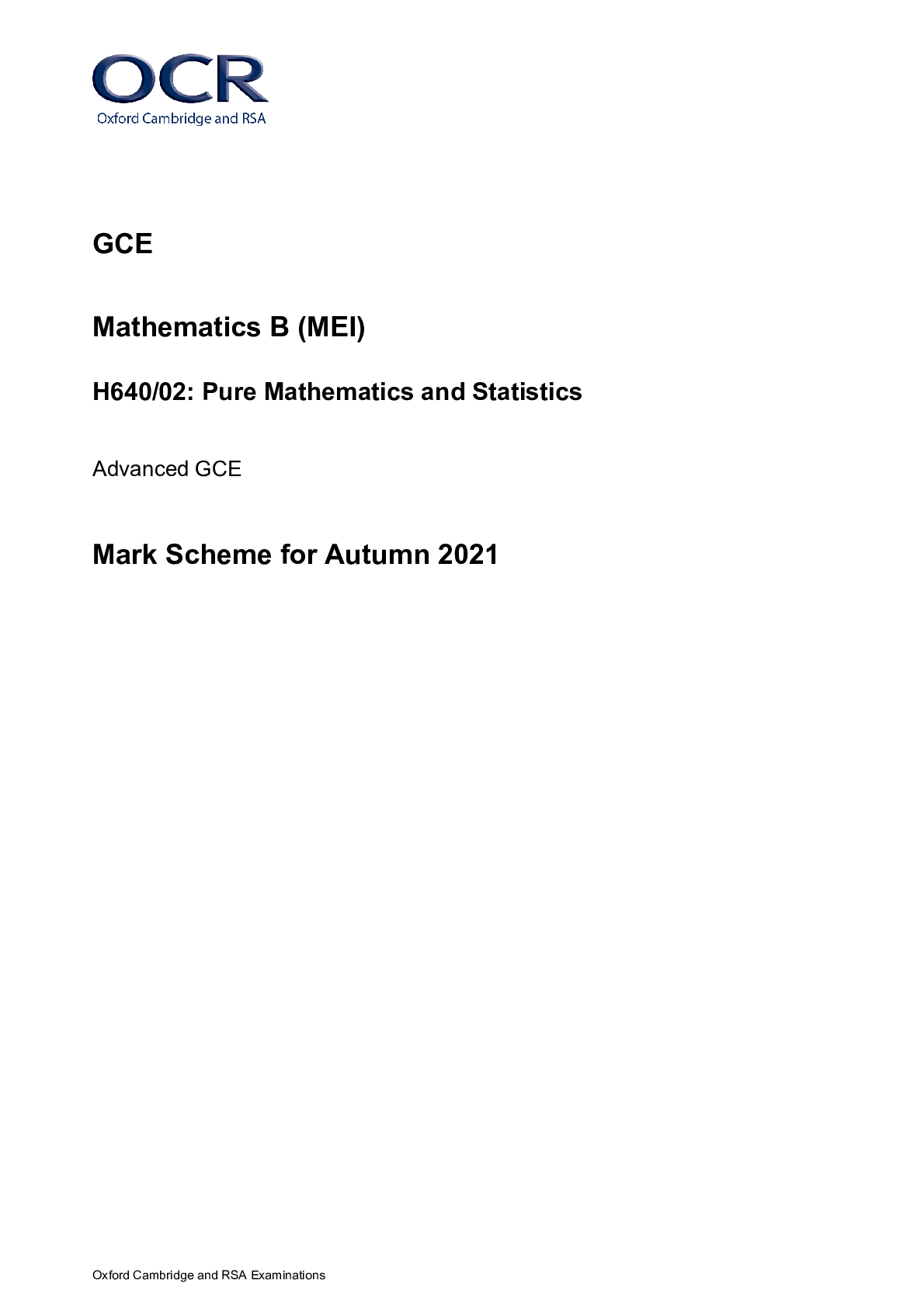
Buy this document to get the full access instantly
Instant Download Access after purchase
Add to cartInstant download
We Accept:

Reviews( 0 )
$7.50
Document information
Connected school, study & course
About the document
Uploaded On
Oct 07, 2022
Number of pages
19
Written in
Additional information
This document has been written for:
Uploaded
Oct 07, 2022
Downloads
0
Views
39


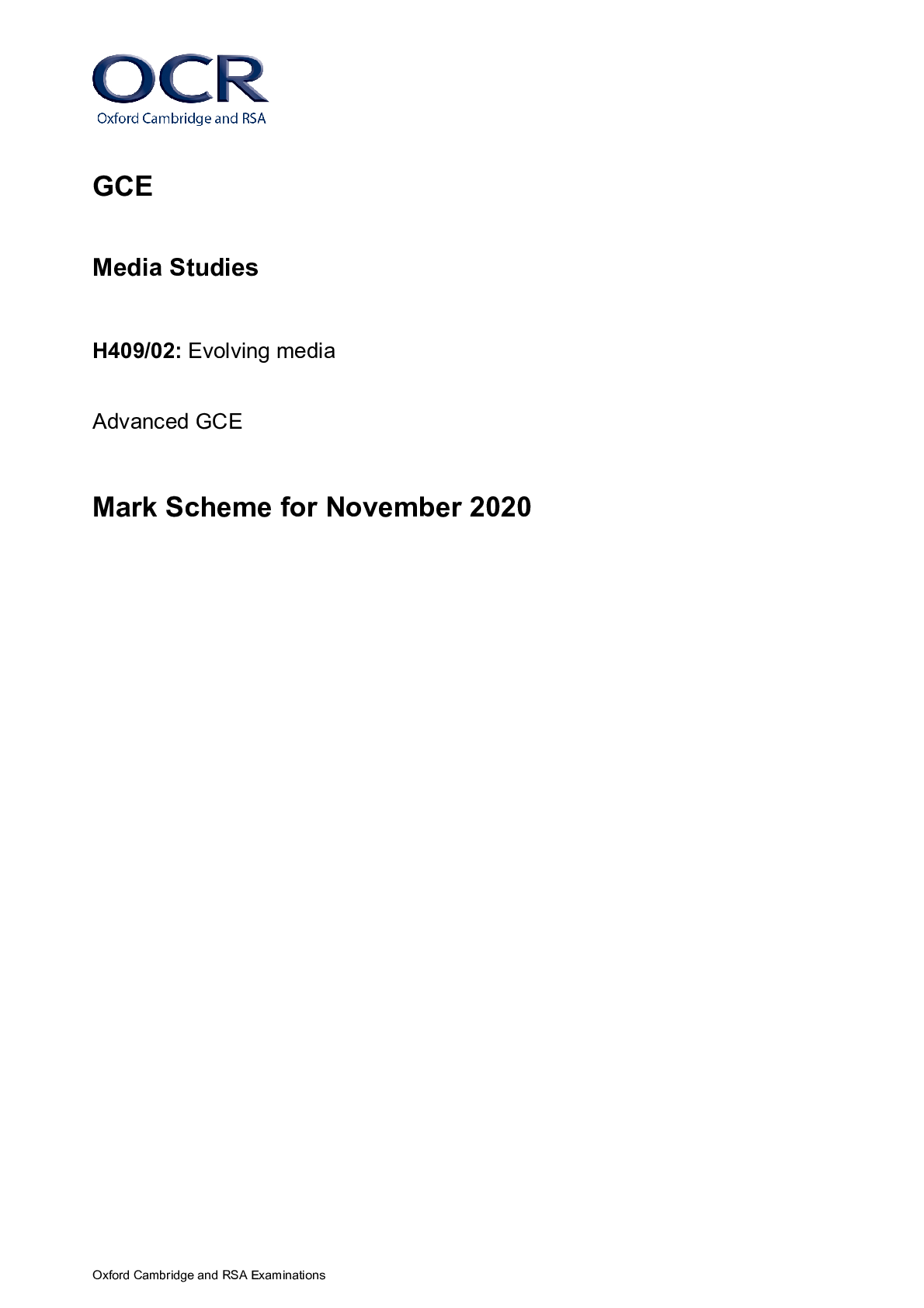
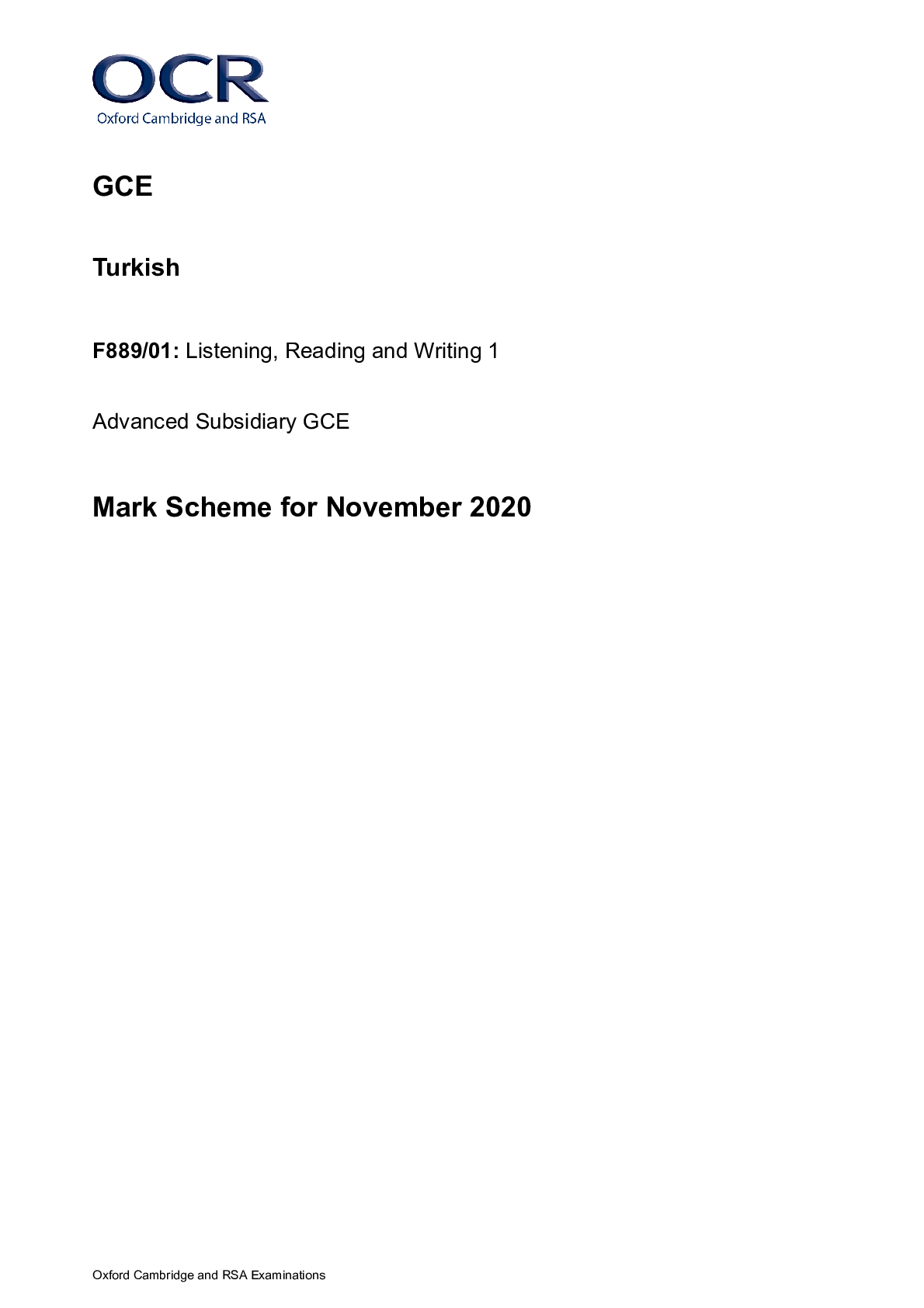
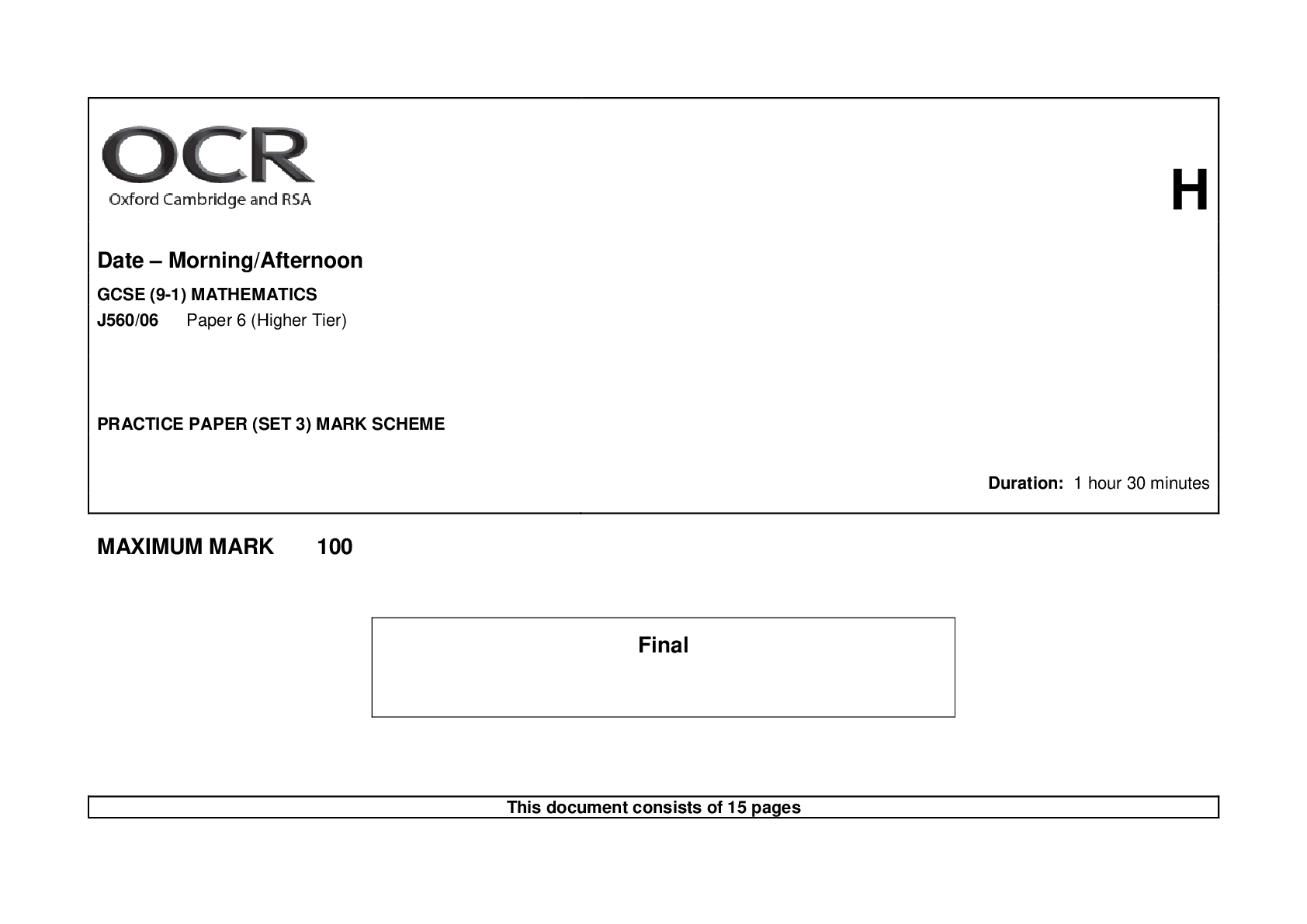


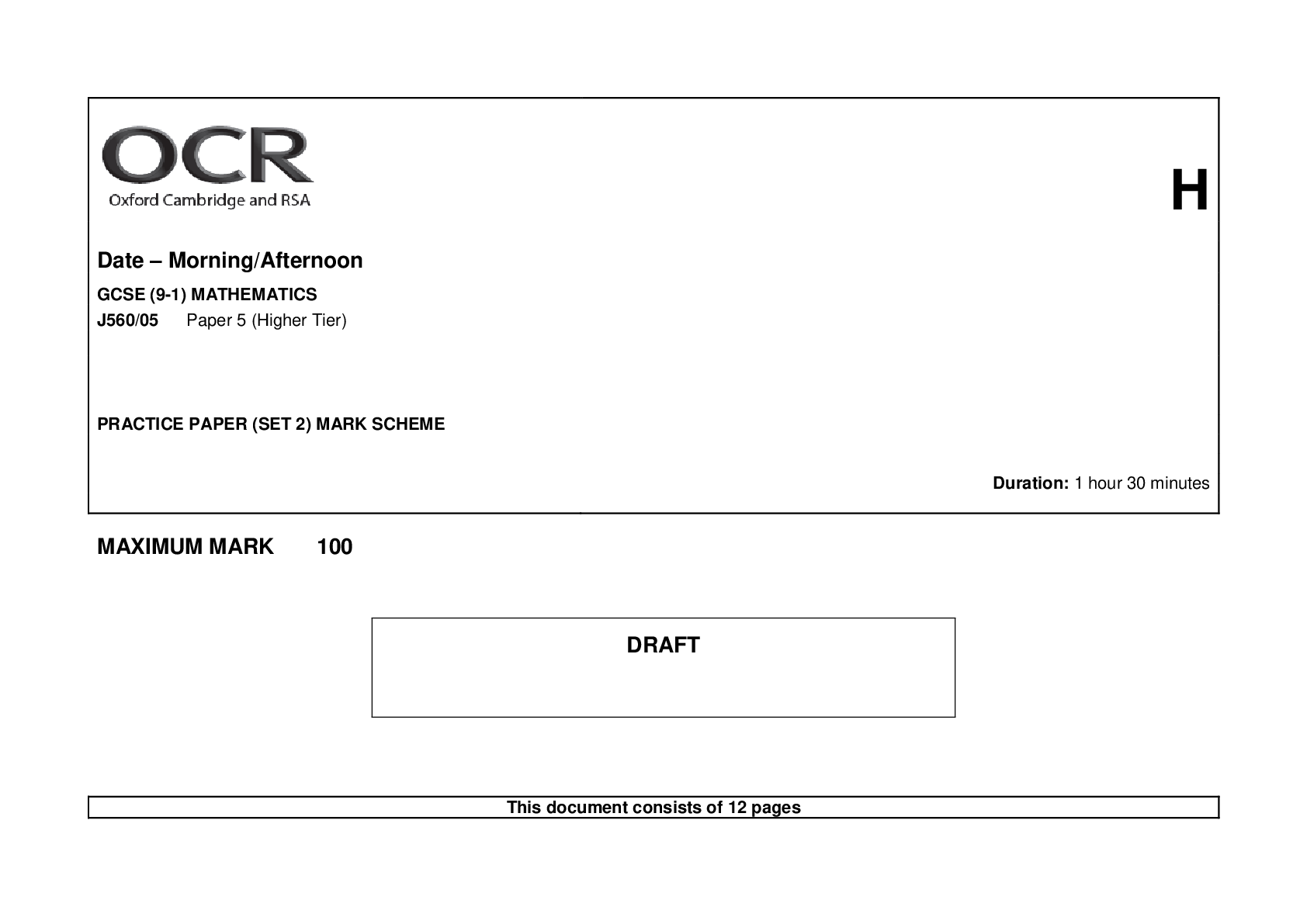
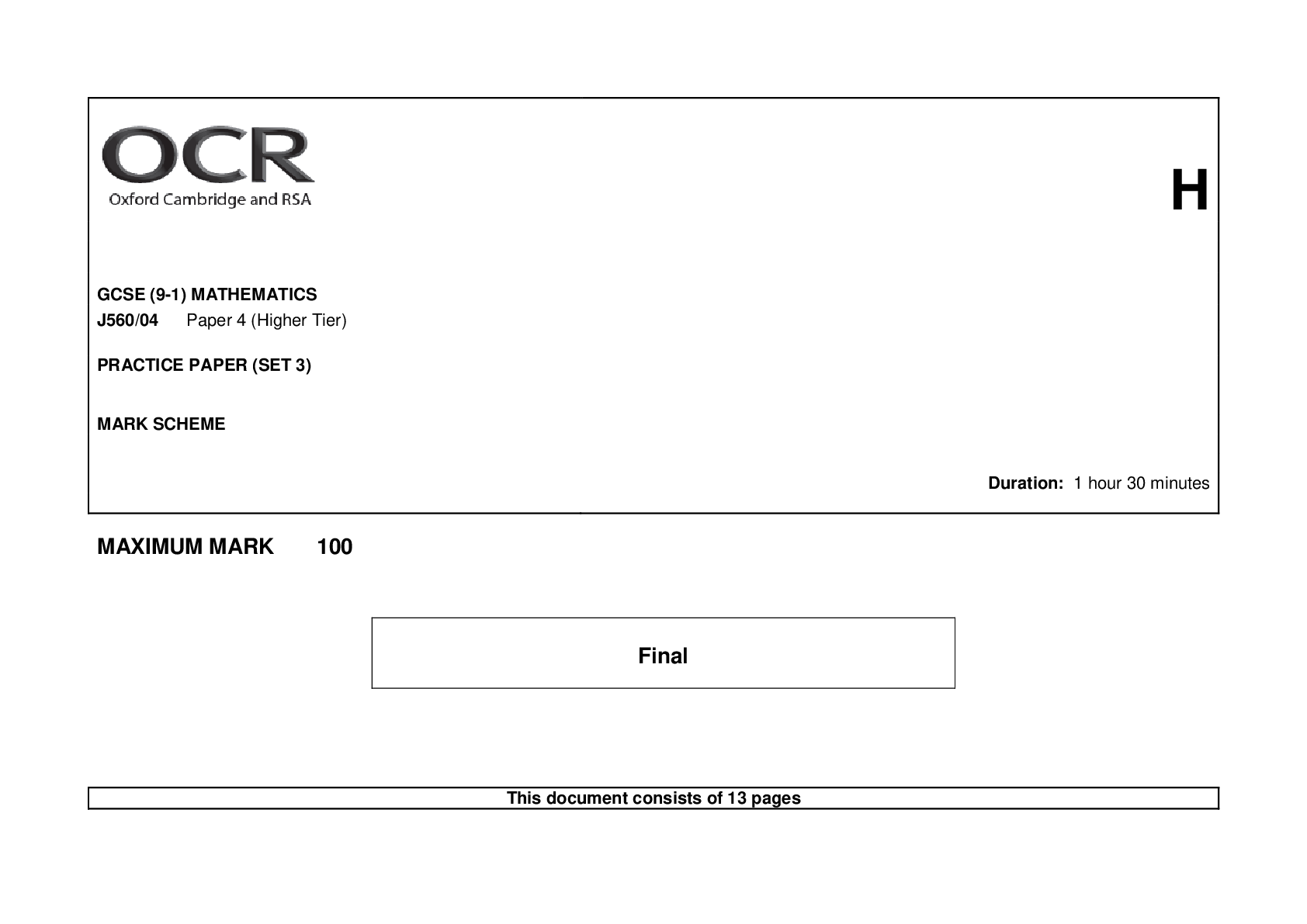



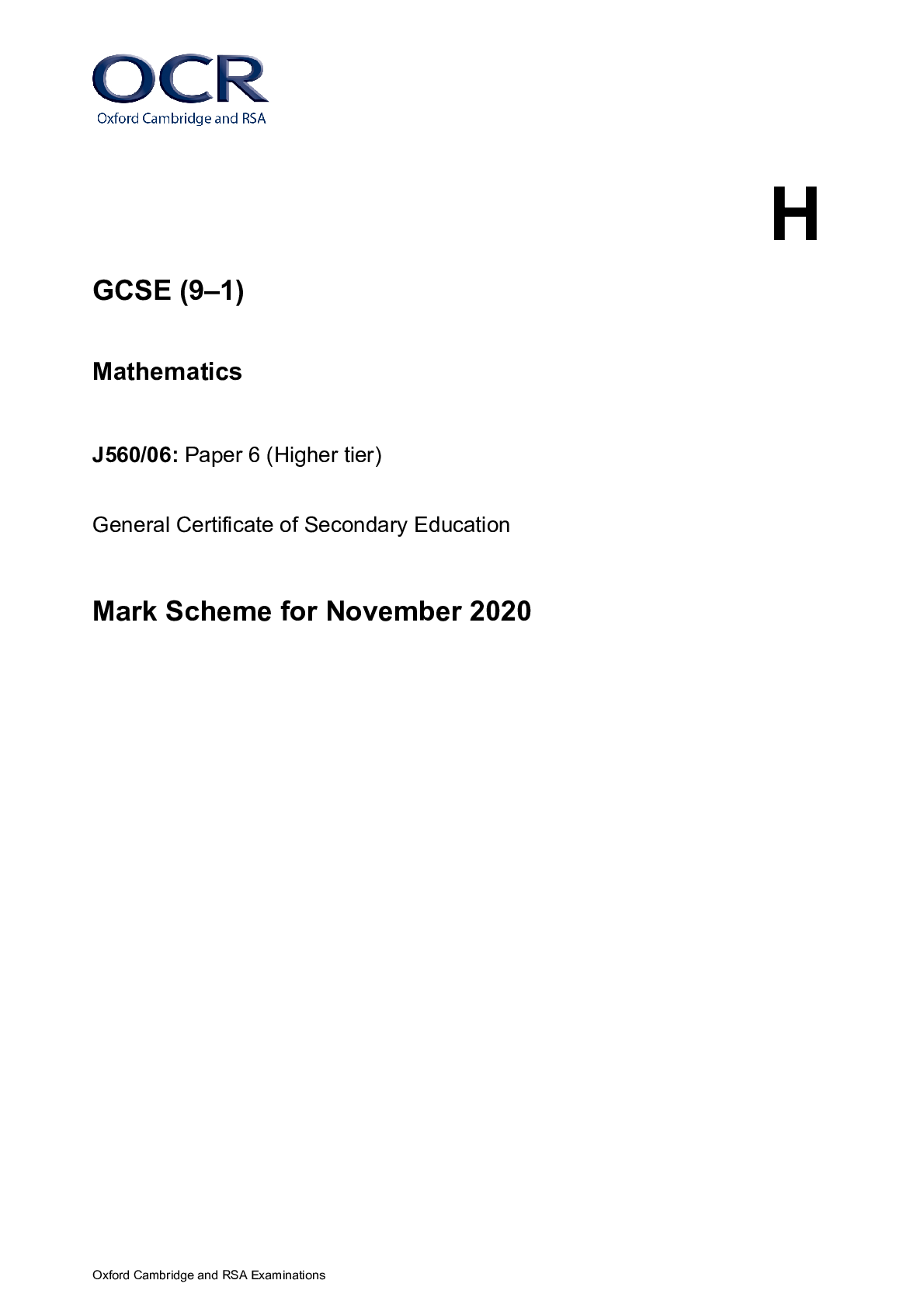
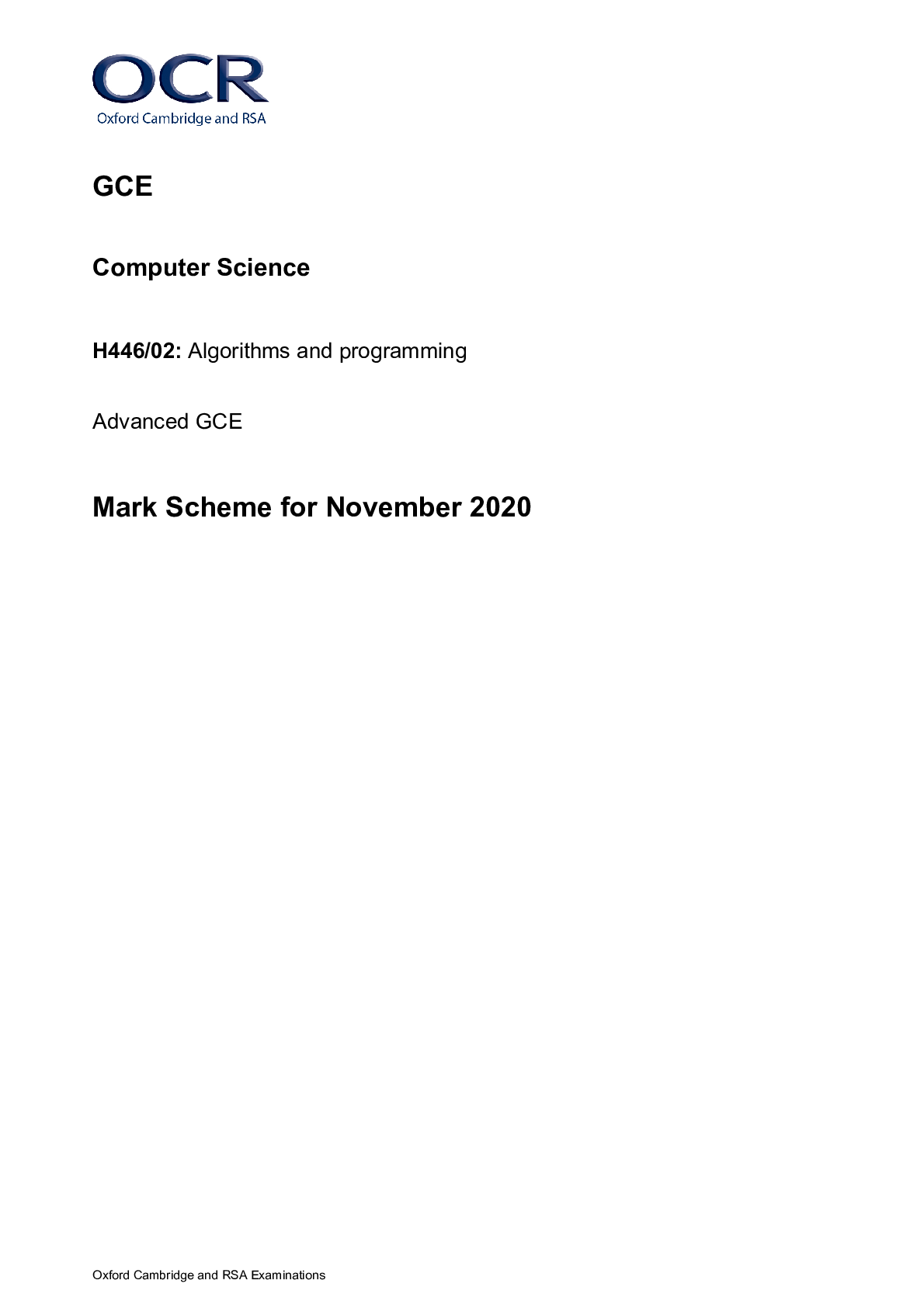
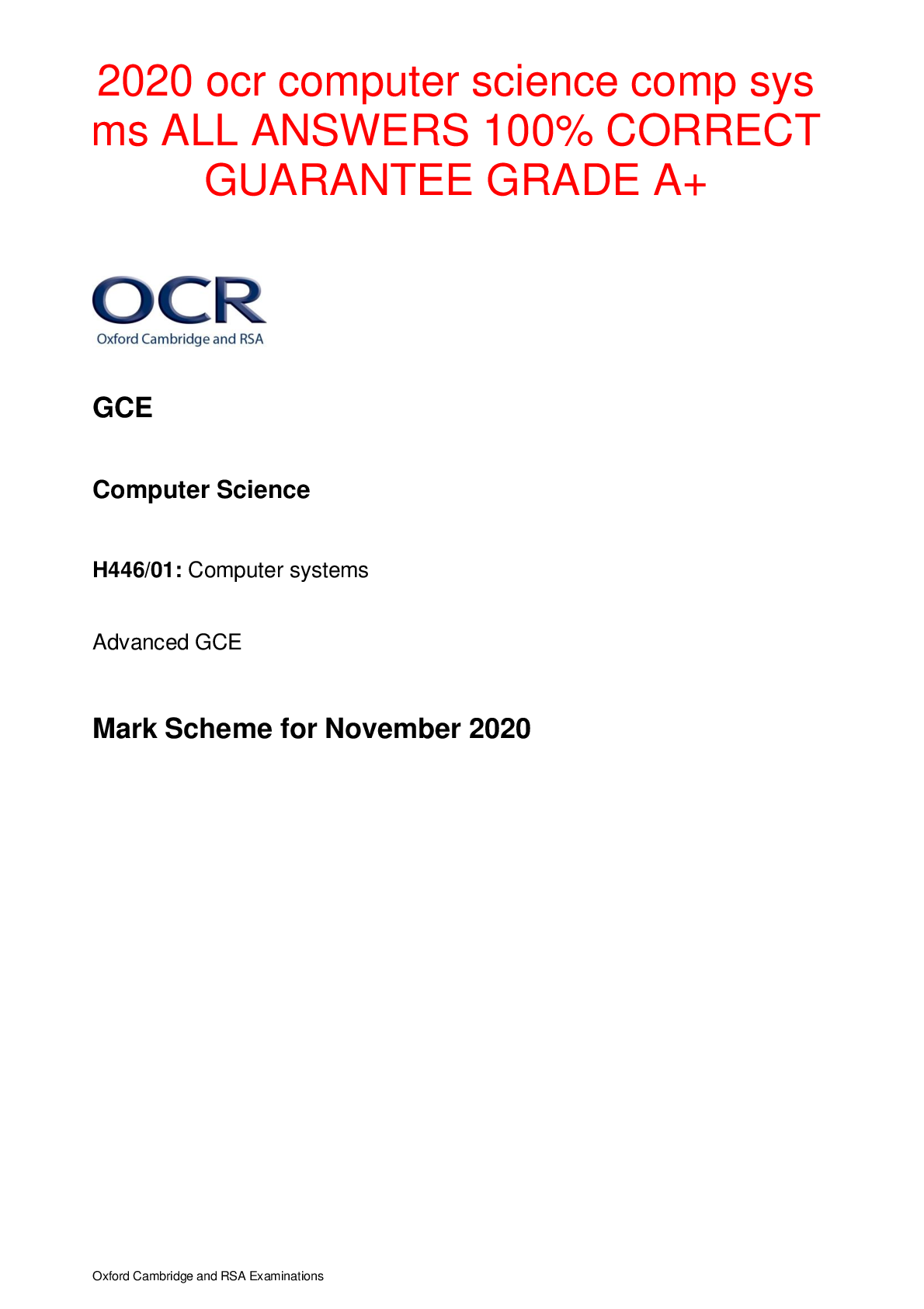
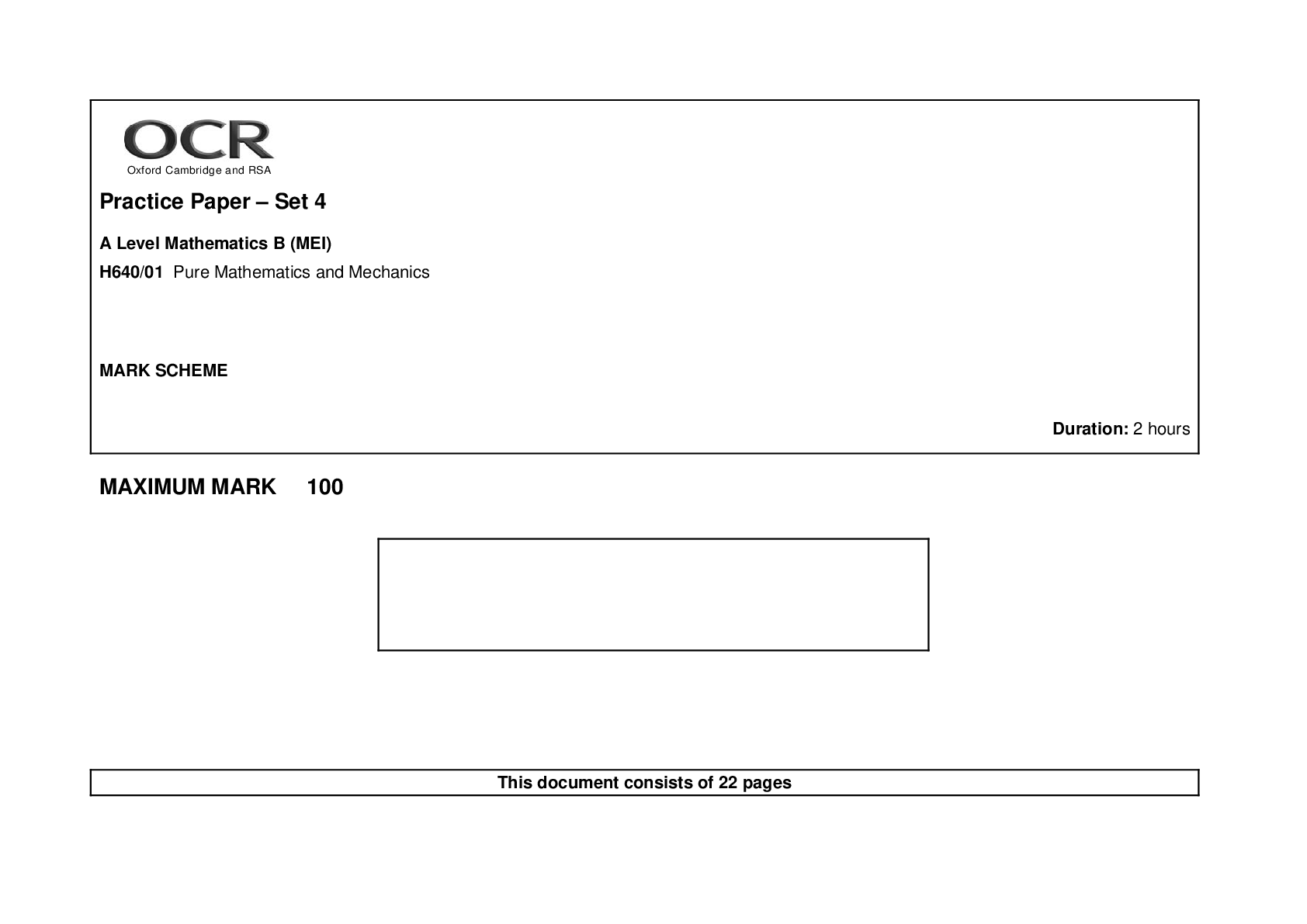
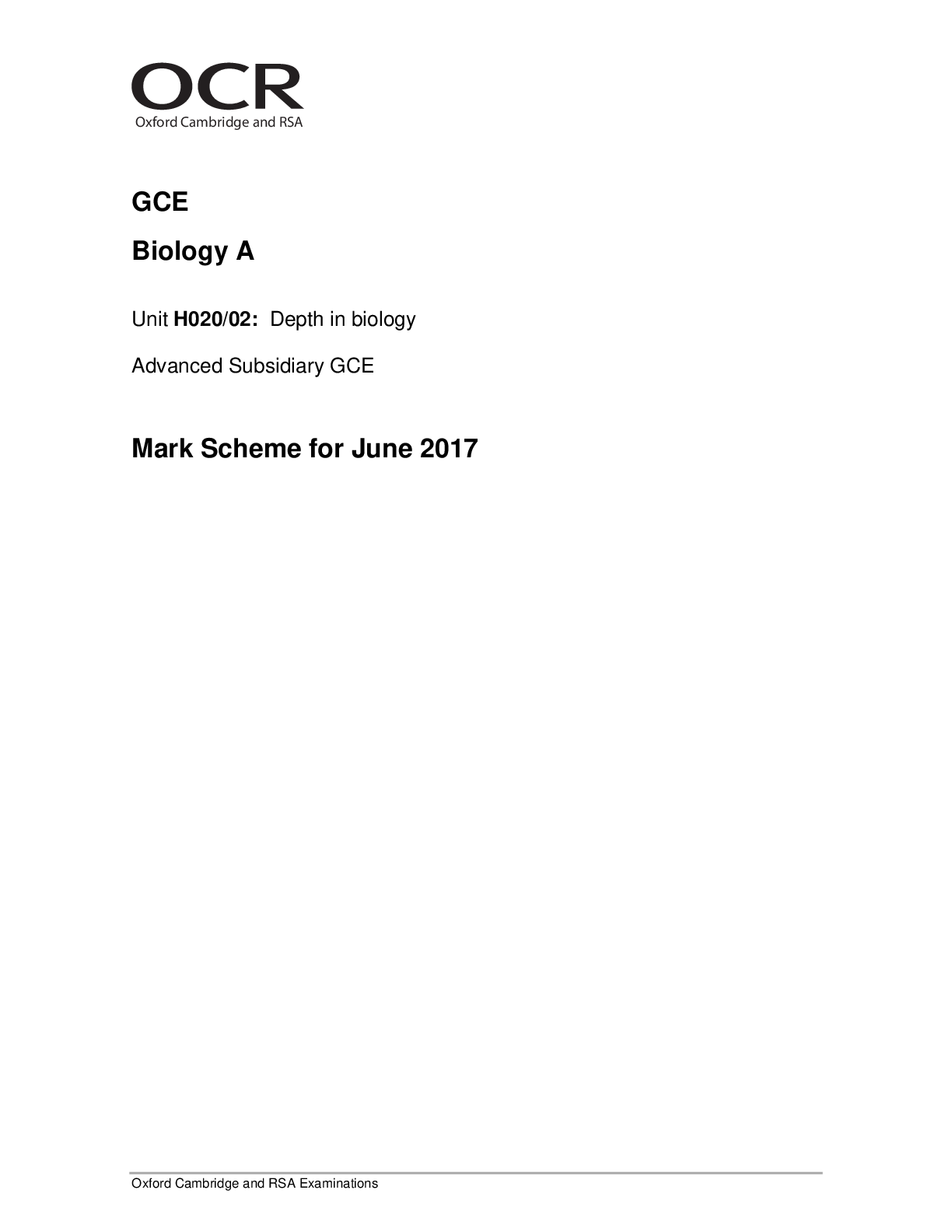


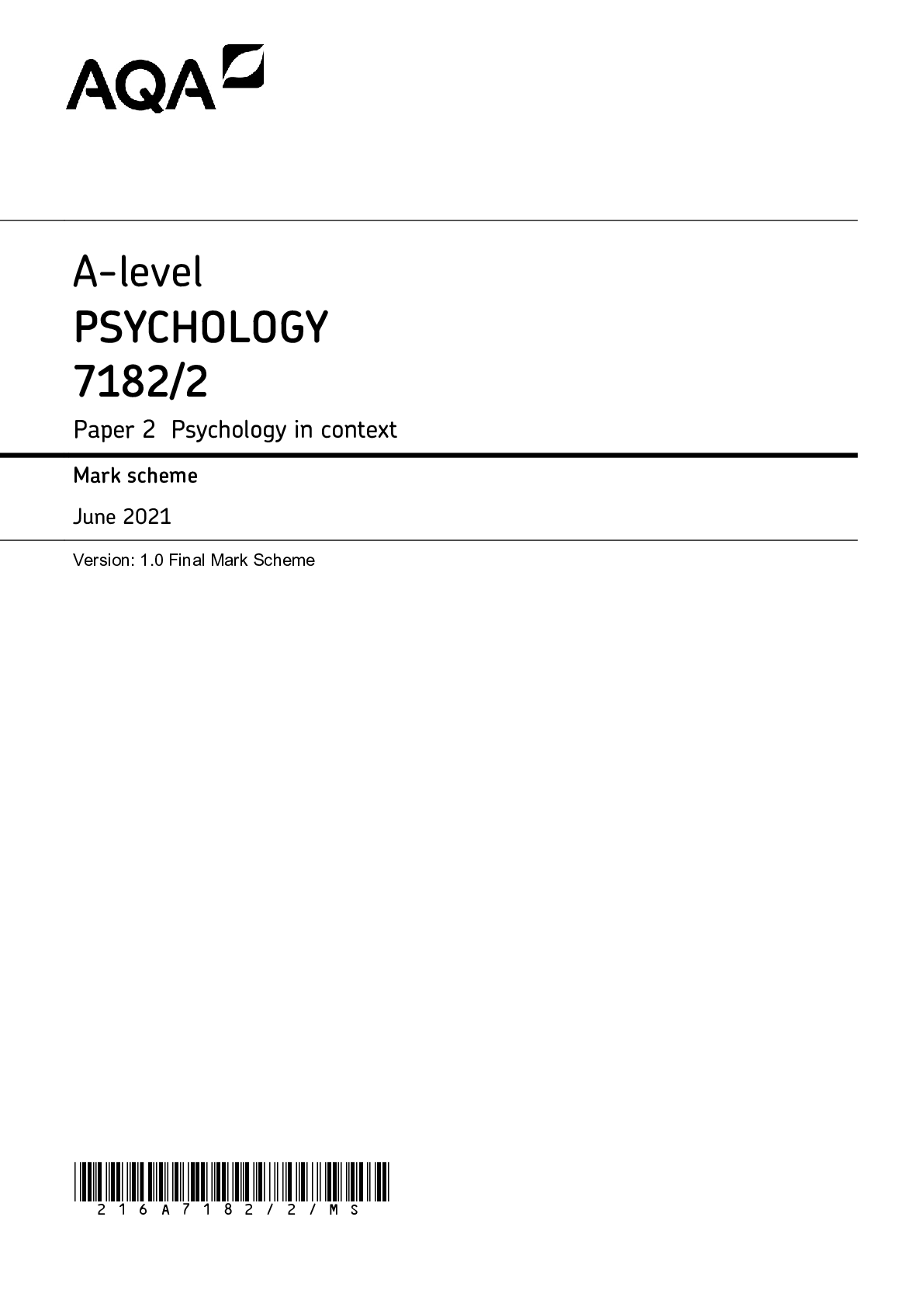
.png)
